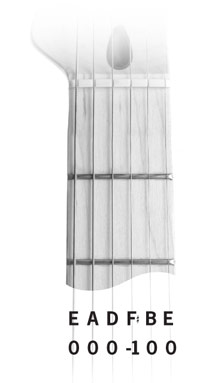
|
本帖*后由 Stone654 于 2016-12-8 20:13 编辑 鲁特调弦:世界上*古老的调弦法 Joe Bennett,翻译Stone654 这是书中记载的*古老的调弦,大概实际上也是世界上*古老的调弦法。它可以追溯到16世纪欧洲文艺复兴时期吉他的祖先鲁特琴,古大提琴以及比尤埃拉琴。鉴于它是一个如此富有挑战性的调弦,你可能不相信它和标准调弦只差了一个音。 鲁特调弦极少用于摇滚和布鲁斯乐,但你偶尔会在民谣中听到它。英国指弹演奏家John Renbourn的Biccle Tune就是一个著名的例子,复古演奏家John Dowland也不出所料地使用鲁特调弦。 
鲁特调弦(音频见原文) 如何调弦:(以标准调弦为基准) 按住四弦四品,调低三弦直到听起来一样。对那些习惯了标准调弦的人来说,鲁特调弦比一些常用的特殊调弦更令人费解,如开放D或DADGAD等,因为指型太过相近。事实上,有些时候这也会带来创新。你可以试着用A和弦的指型弹奏一下,实际上的声音是Amaj7和弦。 理解这一调弦的*好方式是整体向下移动一根弦并保持原指型弹奏。试着保持D指型,但下移到二、三、四弦上弹奏。A指型亦然,然后再扫弦时切换两个指型,你实际上在弹奏A和弦和E和弦。尽管这两个和弦听起来与标弦下没有任何区别,但可以作为一个良好开始。这个调弦的*大好处是F#开放弦的引入。我在这个调弦下写的歌特意用到了这个音,可以带来一种瀑布般的和声感觉。 由于此调弦的声音特性以及简单的开放和弦指型,它格外适合朋克音乐或grunge音乐的节奏部分。但还没有人尝试过这一领域。。。 





附:谱例 ‘Beechen Cliff’ Here, I’ve created a cascading effect known as ‘harping’ using beautiful open harmonics – the riff remains the same throughout the first section; only the bass note changes, so do take time to master the technique before moving on. The second section uses more straightforward techniques, where open strings ring on against fretted notes to create the melody, before returning to the first section. The piece finishes on two high harmonics at the fifth fret. 




原文: Lute Tuning: Tackling the World’s Oldest Tuning Joe Bennett October 21, 2009 This is the oldest tuning in the book; in fact, it’s probably the world’s oldest tuning. It dates back to the 1500s and the guitar’s predecessors – the lute, viola da gamba and vihuela of the European Renaissance. Considering that it’s such a challenging tuning to use, it may come as a surprise that it only differs from regular tuning by one note. Lute tuning is rarely used in rock and blues, but you do occasionally find it in folk music. English fingerstyle player John Renbourn’s track "Bicycle Tune" is one notable example; the guitar transcriptions of Renaissance lutenist John Dowland are also, unsurprisingly, in lute tuning. Lute Tuning - hear it How to tune it (from regular tuning): Fret the fourth (D) string at the fourth fret. Tune the open third (G) string down until it matches. For those used to regular tuning, lute tuning is actually more confusing than something more heavily altered such as open D or DAD-GAD, because the chord shapes are so nearly familiar. Indeed, sometimes this alone can throw up its own ideas. Try a regular ‘A’ chord shape at the second fret – you’re actually playing A major 7. The best way to get your brain round the tuning is to think one string across. Play a normal ‘D’ chord shape, but move it to the fourth, third and second strings (one string across). Do the same with a normal ‘A’ shape, then simply strum between the two shapes. You’re actually playing chords of A and E. OK, so this example doesn’t actually sound any different from normal tuning, but it might help you to get started. The real benefit, of course, comes from that lovely open F# note in the middle of the guitar. The song I’ve written for this tuning makes deliberate use of this note, with a cascading harmonics effect. Because of the deep register and simple open chord shapes, the tuning would lend itself well to punk or grunge rhythm parts, but no-one’s done it yet… |



